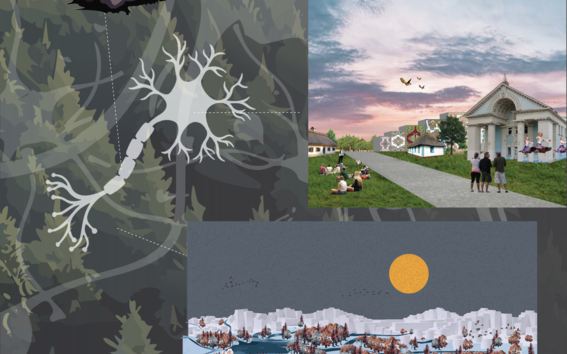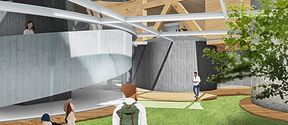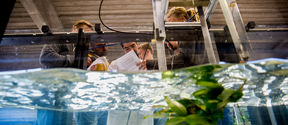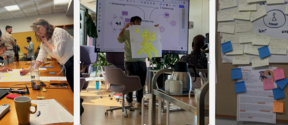Fostering Border Crossing Creativity
Claudia Auer, PhD-researcher and university teacher, practicing architect

Creating a space of agency is a necessity and starting point for fostering border crossing creativity. This space is not only a physical space where multidisciplinary stakeholders act together, but most of all a mental safe space and a rebel mindset, a laboratory where different epistemic modalities can act together.
Institutions like Aalto University have enough critical mass of multidisciplinary minds for potential groundbreaking innovations, but a strategy for radical creativity asks for more than just having different disciplines side by side on one campus. New border-crossing and out-of-the-box-innovation may be unachieved without successful inter-contamination of differing epistemic worlds and co-inspiration happening in multidisciplinary settings. An important question is what kind of mindset is essential in radical creative leadership.
Critical rebellion, resilience towards risk-taking and mistakes, trust in practice, openness towards unknown or even awkward settings, inclusivity of various cultures and various epistemic and social worlds, creation of a low threshold and a communicative safe space with a broad horizon, empathy, emotional resilience, freedom of decision making, and academic autonomy are some essential core concepts for fostering border crossing creativity.
Critical rebellion
A radical creative leader is always at least to some extend an organizational rebel. No paradigm can be broken without questioning an organization’s mindset and usual way of doing business. This includes taking a lot of critique and risks and a trust in one’s own practice – a practice that goes beyond envisioning targets and strategizing. Radical creative practice needs facilitating for an open-end target while protecting creative self-efficacy. A can-do-but-am-I-attitude means having the mind in the clouds but the feet on the ground - pushing for creative ideas and impact and promoting autonomy but also protecting from overambitious goals. Let people do stuff, but also safeguard people, as with too ambitious goals people may burn out. In a creative organization awareness for human resources and wellbeing is crucial, and socially and emotionally smart facilitating forms the basis for unconventional co-operations.
Also, an endless focus on efficiency creates somewhat of a poisonous atmosphere for innovation. In this way a university’s strategy of radical creativity seems somewhat of a contradiction. The neoliberal or political way of staring universities by strategies has taken the foreground before academic autonomy. Researchers and professors are more and more busy with reporting their work and applying for project funding, students are pushed through university education in minimum time. All that seems to be in harsh contradiction to what could be called a basis for radical creativity. That is why fostering groundbreaking leadership means creating empty spaces of opportunity, these spaces of agency, that enable radical creativity as such.
Social and cultural variety
What kind of emotional mindset and what atmospheres are needed to enable spaces of opportunities for new out of the box insight? In academia as in practice high professional standards and good set of skills are a guarantee for high quality work, but the chances for groundbreaking change and novelty are small if we act in well-known channels of our disciplines and practices. Creating opportunities for collision of various epistemic and professional cultures and an inclusive, curious an open mindset can create possibilities for totally new insights. While highly trained homogeneous teams may work together efficiently, teams with broad variety of professional fields and even contradicting cultures, and very different personalities may come up with more groundbreaking and surprising solutions, and non-human actors may turn around traditional best practices. The higher the variety between stakeholders the higher is the difference in understandings of the same issue. Creative minds and thinkers may be quite sensitive, and understandings may be contradicting. The most critical aspect is to create an atmosphere that fosters communication and trust.
Co-inspiration and emotional resilience
A precondition for developing shared understanding and a shared language is, that stakeholders of different epistemic and professional or non-professional background and cultures listen to each other, are willing to cross the borders of their own epistemic confidence, are willing to share their expertise and are coming up with ideas outside one’s own box. Sometimes it also boils down to willingness and trust to share good ideas or business secrets. This only can happen through empathic behavior, and empathy will only happen in a stress free and confident atmosphere. Leadership by control and fear or a competitive setting between included stakeholders are poor tools for paradigm braking creative leadership. Fostering a common culture, emphatic behavior and strengthening emotional resilience and self-esteem of the stakeholders are basic tools for enhancing success in transdisciplinary endeavors. In a non-hierarchical unbureaucratic emotional setting it is possible for stakeholders to overcome their own emotional barriers of understanding and trust. Sometimes even chance, play, humor or other situations, that enhance shared loss of control may boost creative behavior and evolving of unconventional ideas. Building an atmosphere that enacts co-inspiration can be seen as a crucial element for success in radical creativity.
The radical creative laboratory
This inspirational shared space of opportunity can be created through a boundary-object: a common task, a common mission or project, a common laboratory, that is shared by a variety of stakeholders and that allows for flexibility of understandings in different social worlds. A boundary object will create common interest, and a shared language, where various differing insights can inspire one another and bring up new surprising synthesis.
In these shared spaces of opportunities different parties listen to each other in an equal and safe environment while at the same time the variety of differing disciplines and cultures creates a broad potential of co-inspiring insights. A space and atmosphere like this could be called a radical creative laboratory. A university’s radical creative strategy is a call for creating radical creative laboratories that experimentally crosscut through borders of different disciplines and cultures and enable projects, university classes and events where different social worlds are combined and learn to communicate in new ways. This again needs a critical view on the bureaucracies that build up the walls between the different channels of disciplines.
Action
Finally, an extremely important aspect in fostering creativity and in creative leadership is wrapping things together by creating action and concrete outcomes. Every openminded and widely collaborative laboratory needs an output, some kind of target or product, that can be critically evaluated and shared. Any radical creative endeavor would not be creative without a concrete end-product, even if the target would be unknown in the beginning, or even if the product turns out to be a disaster in the end. There is something inherent within creative action and practice that otherwise than by knowing boosts innovative spirit.
22.10.2024
inspired by discussions and workshops organised by the Co-How team and based on interviews with Juha Siltala, Frank Martela, Chris Rose and Ville Eloranta.
image: ICAUS - Irpin, the Future Horizon, proposal "Safe Space",Tuomo Korjus ,Nino Bračevac ,Merle Zipperling
Show other posts from this blog

Recommendations Towards Critical Trans-Disciplinarity
We would like to propose the following recommendations for the basis of strategic tools and methods for radically creative trans-disciplinarity.
Consequential Pragmatism
This blog text discusses methods which combine critical thinking with practicality in architectural design process.
The role of infrastructure in facilitating cross-disciplinarity
Hybrid concepts and metaphors across disciplines are created by working together in concrete material-spatial conditions.